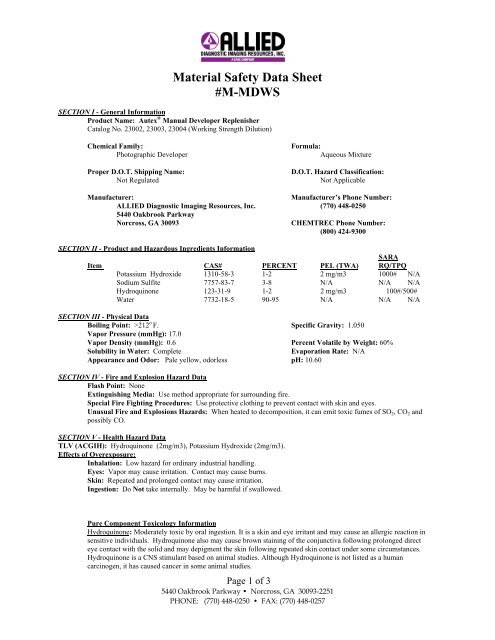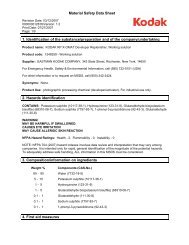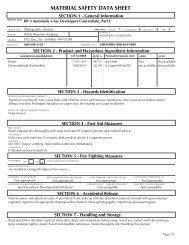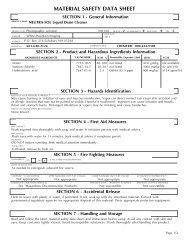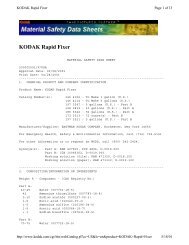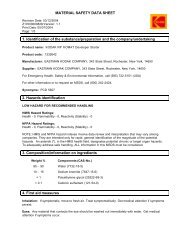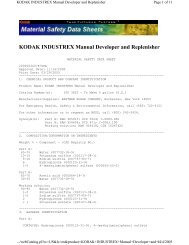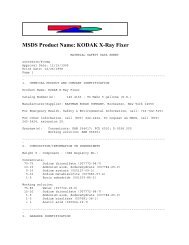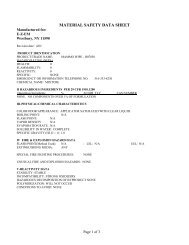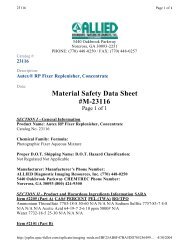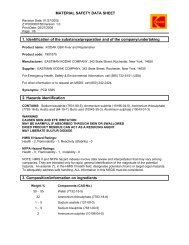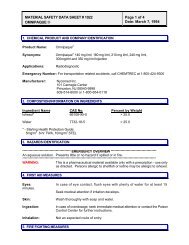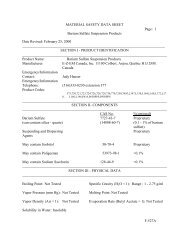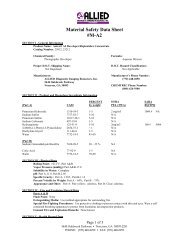MSDS Autex Manual Developer Replenisher Working Strength ...
MSDS Autex Manual Developer Replenisher Working Strength ...
MSDS Autex Manual Developer Replenisher Working Strength ...
You also want an ePaper? Increase the reach of your titles
YUMPU automatically turns print PDFs into web optimized ePapers that Google loves.
Material Safety Data Sheet<br />
#M-MDWS<br />
SECTION I - General Information<br />
Product Name: <strong>Autex</strong> ® <strong>Manual</strong> <strong>Developer</strong> <strong>Replenisher</strong><br />
Catalog No. 23002, 23003, 23004 (<strong>Working</strong> <strong>Strength</strong> Dilution)<br />
Chemical Family:<br />
Photographic <strong>Developer</strong><br />
Proper D.O.T. Shipping Name:<br />
Not Regulated<br />
Formula:<br />
Aqueous Mixture<br />
D.O.T. Hazard Classification:<br />
Not Applicable<br />
Manufacturer:<br />
Manufacturer’s Phone Number:<br />
ALLIED Diagnostic Imaging Resources, Inc. (770) 448-0250<br />
5440 Oakbrook Parkway<br />
Norcross, GA 30093<br />
CHEMTREC Phone Number:<br />
(800) 424-9300<br />
SECTION II - Product and Hazardous Ingredients Information<br />
SARA<br />
Item CAS# PERCENT PEL (TWA) RQ/TPQ<br />
Potassium Hydroxide 1310-58-3 1-2 2 mg/m3 1000# N/A<br />
Sodium Sulfite 7757-83-7 3-8 N/A N/A N/A<br />
Hydroquinone 123-31-9 1-2 2 mg/m3 100#/500#<br />
Water 7732-18-5 90-95 N/A N/A N/A<br />
SECTION III - Physical Data<br />
Boiling Point: >212 o F. Specific Gravity: 1.050<br />
Vapor Pressure (mmHg): 17.0<br />
Vapor Density (mmHg): 0.6 Percent Volatile by Weight: 60%<br />
Solubility in Water: Complete<br />
Evaporation Rate: N/A<br />
Appearance and Odor: Pale yellow, odorless pH: 10.60<br />
SECTION IV - Fire and Explosion Hazard Data<br />
Flash Point: None<br />
Extinguishing Media: Use method appropriate for surrounding fire.<br />
Special Fire Fighting Procedures: Use protective clothing to prevent contact with skin and eyes.<br />
Unusual Fire and Explosions Hazards: When heated to decomposition, it can emit toxic fumes of SO 2 , CO 2 and<br />
possibly CO.<br />
SECTION V - Health Hazard Data<br />
TLV (ACGIH): Hydroquinone (2mg/m3), Potassium Hydroxide (2mg/m3).<br />
Effects of Overexposure:<br />
Inhalation: Low hazard for ordinary industrial handling.<br />
Eyes: Vapor may cause irritation. Contact may cause burns.<br />
Skin: Repeated and prolonged contact may cause irritation.<br />
Ingestion: Do Not take internally. May be harmful if swallowed.<br />
Pure Component Toxicology Information<br />
Hydroquinone: Moderately toxic by oral ingestion. It is a skin and eye irritant and may cause an allergic reaction in<br />
sensitive individuals. Hydroquinone also may cause brown staining of the conjunctiva following prolonged direct<br />
eye contact with the solid and may depigment the skin following repeated skin contact under some circumstances.<br />
Hydroquinone is a CNS stimulant based on animal studies. Although Hydroquinone is not listed as a human<br />
carcinogen, it has caused cancer in some animal studies.<br />
Page 1 of 3<br />
5440 Oakbrook Parkway • Norcross, GA 30093-2251<br />
PHONE: (770) 448-0250 • FAX: (770) 448-0257
Material Safety Data Sheet<br />
#M-MDWS<br />
Sodium Carbonate: Slightly toxic by oral ingestion. It is a moderate to strong skin, eye, and respiratory tract irritant.<br />
Potassium Sulfite and Sodium Sulfite: Slightly toxic by oral ingestion. It is a slight to moderate skin, eye, and<br />
respiratory tract irritant. Some asthmatics or sulfite-sensitive individuals may experience wheezing, chest tightness,<br />
hives, weakness and diarrhea following ingestion.<br />
Potassium Hydroxide- Potassium hydroxide is corrosive to the skin, eyes and mucous membranes. It can cause severe<br />
burns and deep ulceration to the skin if not removed immediately. Contact with eyes can cause corneal and<br />
conjunctival ulceration with loss of sight if not washed out immediately. Ingestion is corrosive to the mouth and upper<br />
gastrointestinal tract and can cause severe abdominal pain, vomiting, diarrhea, collapse and death. Inhalation can<br />
cause irritation of the nose and throat.<br />
Evidence of Carcinogen: Hydroquinone<br />
Teratogenicity: N/A<br />
Reproductive Toxicity: N/A<br />
Mutagenicity: N/A<br />
Synergistic Products: N/A<br />
Emergency First Aid Procedures:<br />
Skin: Wash skin with soap and water. If irritation occurs, seek medical attention.<br />
Eyes: Flush with large amount of water for 15 minutes.<br />
Ingestion: Induce vomiting only as directed by medical personnel. Seek medical attention immediately giving full<br />
details of amount ingested and toxicity.<br />
Inhalation: Move to fresh air.<br />
SECTION VI - Reactivity Data<br />
Stability: Stable.<br />
Incompatibility: Strong bases, strong acids.<br />
Hazardous Decomposition Products: When heated to decomposition, it can emit toxic fumes of SO 2 , CO 2 and<br />
possibly CO.<br />
Hazardous Polymerization: Will not occur.<br />
Conditions to Avoid: None known.<br />
SECTION VII - Spill or Leak Procedures<br />
Steps to be Taken in Case Material is Released or Spilled: Wear protective clothing as specified in Section VIII.<br />
Neutralize with sodium bicarbonate. If federal, state and local laws permit, flush to sewer with large amounts of water.<br />
Waste Disposal: Neutralize with sodium bicarbonate. If federal, state and/or local laws permit, flush to sewer with<br />
large amounts of water. Otherwise, dispose of contaminated product and materials used in cleaning up the spill in a<br />
manner approved for this material. Consult proper federal, state and/or local regulatory agencies to ascertain proper<br />
disposal procedures.<br />
SECTION VIII -Special Protection Information:<br />
Respiratory Protection (Specify Type): Should not be necessary under normal conditions. If exposed to vapors that<br />
exceed TLV or PEL, wear approved vapor respirator.<br />
Protective Equipment:<br />
Gloves: Impervious gloves.<br />
Eyes: Wear protective goggles.<br />
Other: As necessary to prevent skin contact. Eyewash facilities in vicinity of use.<br />
SECTION IX -Special Precautions<br />
Precautions to be Taken in Handling and Storage: Do not store or consume food, drink or tobacco in<br />
surrounding area. Do not store near strong acids or bases. Wash thoroughly after handling.<br />
Page 2 of 3<br />
5440 Oakbrook Parkway • Norcross, GA 30093-2251<br />
PHONE: (770) 448-0250 • FAX: (770) 448-0257
Material Safety Data Sheet<br />
#M-MDWS<br />
The information contained in this material safety data sheet is furnished without warranty of any kind. The user should consider<br />
this data a supplement to other information gathered and must make independent determination of suitability and completeness<br />
of information from this and other sources to assure proper use and disposal of the materials and the health and safety of<br />
employees and customers. This statement is incorporated as part of this Material Safety Data Sheet.<br />
Revised: August 2, 2002<br />
Page 3 of 3<br />
5440 Oakbrook Parkway • Norcross, GA 30093-2251<br />
PHONE: (770) 448-0250 • FAX: (770) 448-0257


